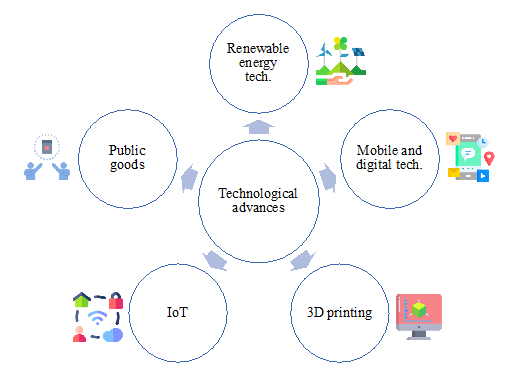New Deployments in Microgrids: Small Productive Processes
Written by Danny Espín-Sarzosa, Rodrigo Palma-Behnke, Marcia Montedonico, and Felipe Valencia-Arroyave
The effects of climate change are forcing countries around the world to change their priorities and mitigation strategies. Such effects can have devastating consequences for human health, biodiversity, and the economy. Additionally, climate change exacerbates existing socioeconomic inequalities, as vulnerable populations are often the most affected and have the least resources to adapt to climate change. Thus, there is a need for resilient and robust decentralized systems that can be self-sufficient (i.e. local territories that can provide water, food, and energy). Robust energy systems are secure, equitable, and environmentally sustainable, showing a carefully managed balance between the three dimensions. In this context, Small Productive Processes (SPPs) can contribute to the self-sufficiency and socioeconomic development of communities. They may become even more critical in helping build resilience and adaptability in vulnerable communities.
Opportunities, Challenges, and Drivers for SPPs Deployment
SPPs can be defined as small manufacturing industries that aim to increase the income and productivity of people in primarily rural communities, along with achieving the Sustainable Development Goals (SDG) [1]. These solutions present different opportunities in their deployment as they offer both the achievement of the SDG and community empowerment. Among the different opportunities, we highlight the following:
- The potential to promote sustainable and inclusive economic growth, particularly in rural areas.
- The ability to contribute to food security and reduce poverty by increasing local production and consumption.
- The potential to develop and adopt climate-resilient practices and technologies.
- The opportunity to promote gender equality and women's empowerment, as women are often involved in small-scale production.
- The opportunity to promote a water-energy-water nexus to provide holistic decentralized solutions at the local level. With this aim, the valuable knowledge that communities have about their own social, cultural, economic, and territorial conditions must be considered [2].
Despite the opportunities and benefits presented by SPPs, they also face several challenges and barriers to their deployment, such as:
- Limited access to financing and markets for small-scale developers.
- Difficulty in adopting new technologies and practices due to the lack of technical expertise and resources.
- Dependence on natural resources, which may be affected by climate change.
- Poor infrastructure, such as limited access to electricity, transportation, and water supply.
- Inadequate policy and regulatory frameworks, which may hinder the growth and sustainability of small-scale production.
- The current Energy Management Systems for microgrids need to be improved for a better representation of SPPs as complex loads [1].
- When decentralized solutions are implemented (e.g., SPPs, microgrids), they are close to the consumption, which can cause a conflict with the territory because they are close to the farms. Then, a competition between energy generation and food is created.
On the other hand, several drivers motivate the development and deployment of SPPs.
- Public policies that promote economic reactivation after the COVID-19 pandemic. For example, Germany, Colombia, and Chile, with the Deutsche Gesellschaft für Internationale Zusammenarbeit (GIZ), established a Triangular Cooperation Project to contribute to mitigating the effects of the sanitary emergency and promote economic reactivation through the generation of a Geographic Information System for the energy potential of renewable sources (biomass residuals and solar) for decision making to enable energy and food security in selected vulnerable areas in Chile and Colombia.
- Increasing demand for goods and services based on sustainable processes.
- Advancements in technology and communication that enable small-scale developers to access markets and information.
- Recognition of the role of small-scale production in achieving sustainable development goals. The World Energy Council considers energy sustainability to be defined by three core dimensions: Energy Security, Energy Equity, and Environmental Sustainability, constituting the so-called Energy Trilemma [6].
- Developers and local organizations could also be promoters, as long as public goods are generated.
Technological Advances for SPPs
Technological advances have played an important role in improving the efficiency, productivity, and sustainability of SPPs. For example, in agricultural SPPs, technologies have been promoted by governments and development organizations as effective ways to increase farm productivity and reduce poverty [3]. Some of the key technological advances for SPPs are shown in Figure 1 and are described in more detail below.
Figure 1. Technological advances for SPPs.
- Renewable Energy Technologies: These include mainly solar and wind power systems that can provide reliable and affordable electricity for small-scale production, even in remote areas. For example, in the northern part of Chile, the solar potential of the area has been used to develop SPPs that integrate solar energy into traditional production processes [4]. Figure 2 shows some examples of solar-based SPPs.

Figure 2. Solar-based SPPs installed in northern Chile (based on [4]).
- Mobile and Digital Technologies: These include mobile phones, apps, and cloud-based platforms that can enable SPP developers and owners to access information, markets, and financial services at low cost.
- Additive Manufacturing/3D Printing Technologies: These can enable SPP developers to manufacture customized products, parts, and spare parts, reducing the need for large-scale manufacturing and transportation. Because of this, there is less waste during the production process which can save the manufacturer money [5].
- Internet of Things (IoT) Technologies: These include sensors, smart meters, and other devices that can monitor and control SPPs, reducing waste and improving efficiency. The result will be reduced downtime, improved quality, reduced waste, and lower costs. This technology will lead to the development of new types of jobs for the manufacturing workforce [5]. Sensors associated with agrivoltaic systems are a good example in this field.
- Public Goods: These include databases (e.g., wind and solar resource maps, guidelines, building plans, operation manuals, etc.) that are generally developed by government institutions, and that SPP developers can access without incurring excessive costs [4].
Importance of SPPs in the Smart Grid Context
SPPs are important in the Smart Grid context because they can play a key role in improving the flexibility, efficiency, and sustainability of smart systems such as microgrids. SPPs that include distributed generation, such as photovoltaic systems, and wind turbines, among others, can supply the needed energy for water demand and the production of food close to consumers, reducing the need for long distances to transport food and electricity. This can help foster community self-sufficiency, reduce energy losses, increase grid reliability, and promote energy independence and resilience. Moreover, because SPPs generate electricity from renewable sources, they can reduce greenhouse gas emissions and promote sustainable development in the context of smart grids. Likewise, some SPPs may include energy storage systems, which can balance supply and demand in Smart Grids. Additionally, SPPs based on Smart Grid approaches can deal with the aforementioned Energy Trilemma.
Strategies for SPPs Deployment
Deploying SPPs involves several stages that vary depending on the specific type of production process, location, and project scale. Generally speaking, each community technology innovation project is also a social project, addressing the needs and problems of the beneficiary communities [2]. Most of these innovation projects implement a participative process, which is an instance that involves "gameplay", content, duration, and call. For example, considering the experiences accumulated in the various social scenarios where these projects have been applied in Chile, a participative methodological approach called "co-construction" was proposed based on the following principles [2]:
- Community engagement,
- Local knowledge
- Transdisciplinary
- Participation
Overall, deploying SPPs requires a multidisciplinary approach involving engineering, social sciences, finance, and policy expertise. Access to data sources and other public goods plays a key role for SPP developers in deploying these types of projects. Moreover, a collaboration between stakeholders such as government agencies, local communities, and private sector actors is also key to ensuring the success of SPPs deployment.
Anticipated Risks, Impacts, and Benefits of SPPs
SPPs present different risks, impacts, and benefits depending on the type of production process, technology, location, and project scale. Nevertheless, some aspects mentioned above are:
- Risks: Due to environmental conditions that may change considerably due to climate change, regulatory and financial.
- Impacts: SPPs impact social systems and local, positive environmental impacts (reducing carbon emissions) and negative environmental impacts (competition for land use), and economic impacts benefiting communities.
- Benefits: Throughout this article, several benefits of SPPs were detailed, among which the following stand out contributing to the self-sufficiency and socioeconomic development of communities, climate change mitigation, and promoting local empowerment and social equity.
References
- D. Espín-Sarzosa, R. Palma-Behnke and F. Valencia, "Integration of Small Productive Processes into an Energy Management System for Microgrids", IEEE Access, vol. 10, pp. 69010-69030, 2022, doi: 10.1109/ACCESS.2022.3185656.
- R. Palma-Behnke et al., “Lowering Electricity Access Barriers by Means of Participative Processes Applied to Microgrid Solutions: The Chilean Case”, Proceedings of the IEEE, vol. 107, no. 9, pp. 1857-1871, Sept. 2019, doi: 10.1109/JPROC.2019.2922342.
- S. Ruzzante, R. Labarta and Amy Bilton, “Adoption of agricultural technology in the developing world: A meta-analysis of the empirical literature”, World Development, vol. 146, 2021, 105599, https://doi.org/10.1016/j.worlddev.2021. 105599.
- Ayllu Solar, “Reference projects”, https://ayllusolar.cl/en/home/ (accessed February 26, 2023).
- B. Vickery, “Five Technological Applications Impacting Manufacturing Innovation”, https://www.nist.gov/blogs/manufacturing-innovation-blog/five-technological-applications-impacting-manufacturing (accessed February 26, 2023).
- World Energy Council, “World Energy Trilemma Index”, https://www.worldenergy.org/transition-toolkit/world-energy-trilemma-index (accessed March 2, 2023).
This article was edited by Hossam Gabber
To view all articles in this issue, please go to April 2023 eNewsletter. For a downloadable copy, please visit the IEEE Smart Cities Resource Center.




To have the Bulletin delivered monthly to your inbox, join the IEEE Smart Grid Community.
Past Issues
To view archived articles, and issues, which deliver rich insight into the forces shaping the future of the smart grid. Older Bulletins (formerly eNewsletter) can be found here. To download full issues, visit the publications section of the IEEE Smart Grid Resource Center.





